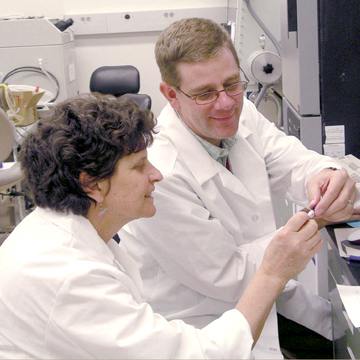
Thanks to their experiences at Sandia, 31 teachers are better prepared to teach applied science at school this year. The teachers participated in DOE’s Academies Creating Teacher Scientists (DOE ACTS) summer program. DOE funds this three-year program at several laboratories throughout the complex including Sandia/New Mexico and Sandia/California.
The goals of the ACTS program are to enhance teachers’ content knowledge; to expose them to real-life research to assist them in teaching applied science; to better prepare teachers to encourage students to pursue science, technology, engineering, and math careers; and to encourage them to become science leaders in their schools and districts.
Teachers receive a $3,200 stipend for their work in the program. They are also eligible to receive up to $2,000 in classroom materials and up to $2,000 for professional development activities during the following school year.
Sandia/California conducted the program for the first time this summer and included 10 teachers.
“The mentors, the lectures, and the class lessons were all instrumental in the value of what we gained this summer,” says participant Kari Salomon. “Our students will have even better teachers next year and will have science topics much more current than those in the textbooks.”
The four-week program at Sandia/California involved learning about basic science related to unique scientific and engineering activities. Topics included transportation/combustion energy, hydrogen science, chemistry related to homeland security, and nuclear weapons- related topics.
“We took advantage of our location in the Bay Area and scheduled weekly outings to our science institution partners like the California Academy of Sciences, Exploratorium, The Tech Museum, and NASA Ames,” says Ray Ng (8248).
The focus of the ACTS program at Sandia/New Mexico is to improve middle school teachers’ understanding and knowledge of emerging trends in water resources, energy development and growth, and impacts on the environment, with an emphasis on sustainability.
Joining experts in these fields, teachers participated in a short research experience, took field trips and tours, and heard a variety of speakers — all aimed at improving their understanding of water and energy challenges and potential solutions, science and engineering careers, and strategies for better preparing students for the workforce. By videotaping their ACTS experiments, participants were able to develop and implement professional development opportunities for other teachers. Pedagogy content focused on systems thinking/dynamics.
“We strive to provide content knowledge through experiential learning, using resources that are unique to our national laboratory,” says Amy Tapia (3652),
Sandia/New Mexico program manager. “One of the most rewarding aspects is providing an environment where teachers can expand their own knowledge of scientific applications and rejuvenate their love of science.”
The ACTS program selects teachers from throughout the nation. Participating teachers this year came from California, New Mexico, Alaska, Ohio, Georgia, Minnesota, Kansas, Oregon, Colorado, and Pennsylvania.
“I have really appreciated being part of this program for the past three years,” says Joshua LaClair, who this year completed his final summer as an ACTS teacher.
“It has changed me into a better educator. I hope this program continues to offer other teachers the same experience.”